Reviewed By COLIN SKELLY

Colin is a Horticulturist and Horticultural Consultant with experience in a range of practical and managerial roles across heritage, commercial and public horticulture. He holds the Royal Horticultural Society’s Master of Horticulture award and has a particular interest in horticultural ecology and naturalistic planting for habitat and climate resilience.
IN THIS GUIDE
- 1) R. luteum
- 2) R. quinquefolium
- 3) R. schlippenbachii
- 4) R. viscosum
- 5) R. ‘Cecile’
- 6) R. gibraltar
- 7) R. ‘Hino Crimson’
- 8) R. ‘Purple Splendor’
- 9) R. occidentale
- 10) R. ‘Delicatissimum’
- 11) R. ‘Mother’s Day’
- 12) R. ‘Fruit Salad’
- 13) R. ‘Elsie Lee’
- 14) R. ‘Schneeperle’
- 15) A. ‘George L. Taber’
- 16) R. ‘Addy Wery’
- 17) R. ‘Iro Hayama’
- 18) R. ‘Panda’
- 19) The Encore Series
- Azalea Types Explained
- Evergreen
- Deciduous
- References
Azaleas are prized in Japan and have been so since hundreds of years ago when gardeners cultivated them for Imperial gardens.
By now there are over 10,000 registered or named varieties worldwide.1Azalea Society of America. (2018b, August 14). Learn about azaleas. Retrieved March 10, 2023, from https://www.azaleas.org/about-azaleas/
Among the untold many thousands of varieties of Azaleas, we present a representative selection from the various groups, several of the most popular ones, and our favourites.
“Due to the large number of Azaleas that have been hybridised and the many species available, there is an Azalea to suit every garden, from full sun to shade, from dwarf to large shrub,” shares Colin Skelly, who has almost 15 years of experience as a Horticulturist and Consultant.
“Look out for the RHS AGM label for tried and tested plants in gardens or try something more rare and unusual.”
1) R. luteum

- COMMON NAME: COMMON YELLOW AZALEA
- NATIVE AREA: CAUCASUS
- TYPE: Pentanthera
Attains a height of 2-3m and a spread of up to 2m.
This is a Caucasus-region species naturalised in the UK.
Classic funnel-shaped flowers are small at about 4.5cm and are a lovely buttery yellow and display long, prominent stamens.
It is also very fragrant.
2) R. quinquefolium

- COMMON NAME: CORK AZALEA
- NATIVE AREA: JAPAN
- TYPE: DECIDUOUS
A Japanese species that is grown as a shrub, this species can grow to be a tree up to 7m tall.
It is also unusual both in its foliage and its flower.
The leaves, of a normal size and colour, display a purplish rim.
The small 3-4cm flowers are unusual in being pendent and bell-like.
They have smooth, pure white petals with faint green spots on the upper three petals and they bloom in late April and May.
3) R. schlippenbachii

- COMMON NAME: ROYAL AZALEA
- NATIVE AREA: KOREA, JAPAN, RUSSIA
- TYPE: DECIDUOUS
This is a species native to Korea, Japan and the Russian Far East.2Rhododendron schlippenbachii Maxim. (n.d.). Kew Royal Botanic Gardens. Retrieved March 10, 2023, from https://powo.science.kew.org/taxon/urn:lsid:ipni.org:names:333307-1
Commonly grown to 1-2m, this variety can reach an ultimate height of 5m; it is very cold-hardy.
The foliage is of particular note as the leaves are red-bronze when they emerge and in the autumn present a stunning show in yellows, oranges, and reds.
The marvellous flowers are unusually open, are about 6 centimetres, and have smooth petals.
The gentle fragrance perfectly matches the gentle hue of a translucent pale pink.
4) R. viscosum

- COMMON NAME: SWAMP AZALEA
- NATIVE AREA: UNITED STATES
- TYPE: Pentanthera
- RHS AWARD OF GARDEN MERIT
This bushy plant is a species native to Eastern and South-Eastern United States.3Rhododendron viscosum. (n.d.). Wildflower Center. Retrieved March 10, 2023, from https://www.wildflower.org/plants/result.php?id_plant=rhvi2
It usually grows to a height of about 2m and spread of about 1.5m. It is very cold-hardy.
The foliage has autumn interest, presenting shades of yellow, orange and purple.
The small, tubular-funnel flowers are only 2-2.5cm across and have narrow petals whose colour varies; they can be pure white, white with pink flecks and streaks, or some tone of pink.
It is a profuse bloomer. Flowers have a spicy, delightful fragrance.
5) R. ‘Cecile’
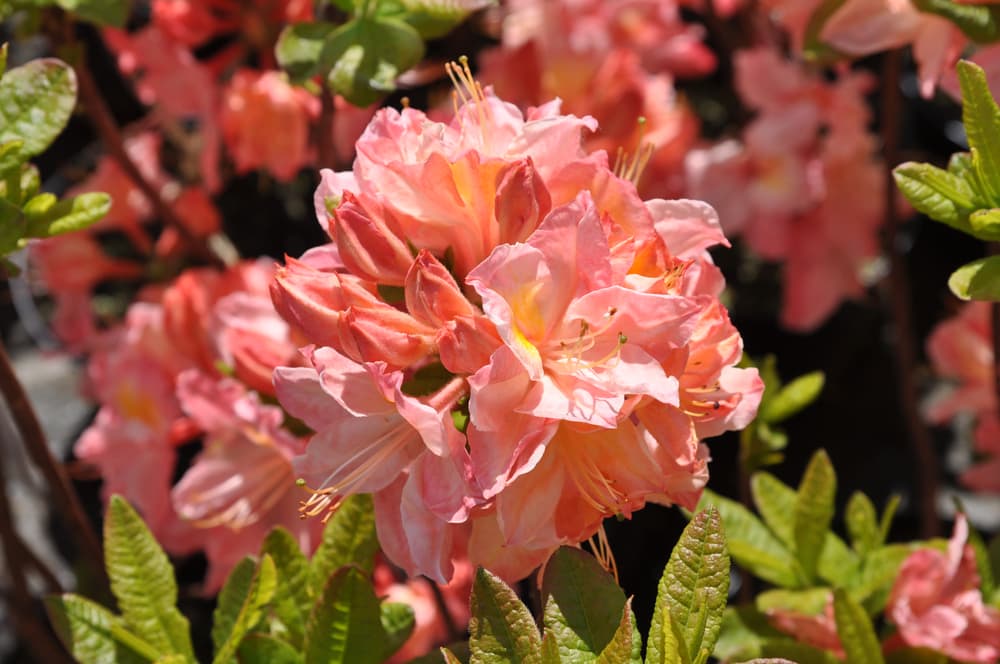
- COMMON NAME: CECILE
- NATIVE AREA: CULTIVATED
- TYPE: Knap Hill
- RHS AWARD OF GARDEN MERIT
The plant has a bushy habit and reaches about 2m in height and spread.
The flowers are large at 8-10cm.
These have beautiful, gently-ruffled petals of a soothing pink shade, often gently gradated, with a reddish throat and yellow-orange flare on the dorsal petal.
Flowers bloom in May through June. Compare with ‘Berry Rose.’
6) R. gibraltar

- COMMON NAME: GIBRALTAR
- NATIVE AREA: UNITED STATES
- TYPE: Knap Hill (Exbury)
- RHS AWARD OF GARDEN MERIT
The plant reaches a height of 1.5-2m and spread of 1-1.5m.
The petals with their curls and frills impart a pleasingly ruffled appearance to the flowers.
The colour is rich and intense, from a flame orange to proper vermilion, often with a yellow tinge.
Medium-sized, about 6cm flowers are fragrant. They bloom in May.
7) R. ‘Hino Crimson’

- COMMON NAME: HINO CRIMSON
- NATIVE AREA: JAPAN
- TYPE: Kurume
- RHS AWARD OF GARDEN MERIT
This semi-dwarf attains a height and spread of about 1m.
Foliage has some winter interest as it becomes reddish.
Small, 4.5cm single form flowers with smooth, flattish petals bloom in May.
They are a solid colour; an intense, thrilling hue of pinkish-red.
8) R. ‘Purple Splendor’

- COMMON NAME: PURPLE SPLENDOR
- NATIVE AREA: UNITED STATES
- TYPE: Evergreen
Usually grows to 1-2m but can attain a height of 3m.
It has a bushy and spreading habit; it is quite cold-hardy.
Flowers are both large at about 8cm and also bloom profusely in May.
The petals are smooth, while the colour is a rich shade of purple with a dark or red throat and a flash with freckles on the dorsal petal.
9) R. occidentale

- COMMON NAME: WESTERN AZALEA
- NATIVE AREA: UNITED STATES
- TYPE: Pentanthera
- RHS AWARD OF GARDEN MERIT
Though its 10-year height and spread is about 2m, this species can grow to several metres.
Fully open, the funnel-shaped flowers present a star-like appearance.
They are pure white, or white with pink streaks and tinges and yellow flares, or some pastel tone.
The flowers are very special, being large at 10cm, sweetly fragrant, and blooming in late spring and early summer – June and July.
10) R. ‘Delicatissimum’
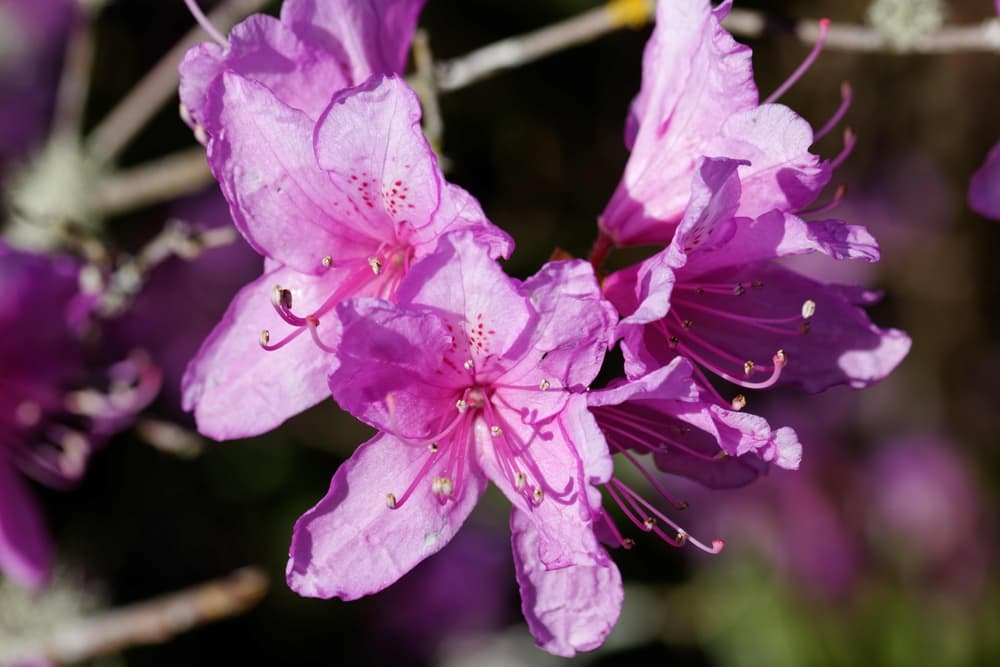
- NATIVE AREA: EAST ASIA
- TYPE: Deciduous
- RHS AWARD OF GARDEN MERIT
This variety has a compact, bushy habit and reaches a height and spread of 1-1.5m.
Foliage provides some autumn interest.
Trumpet-shaped flowers present a ‘delicate’ appearance, and are pale cream with a pale pink flush, a pink streak or sector, and a yellow flare.
They are fragrant and bloom through June.
11) R. ‘Mother’s Day’
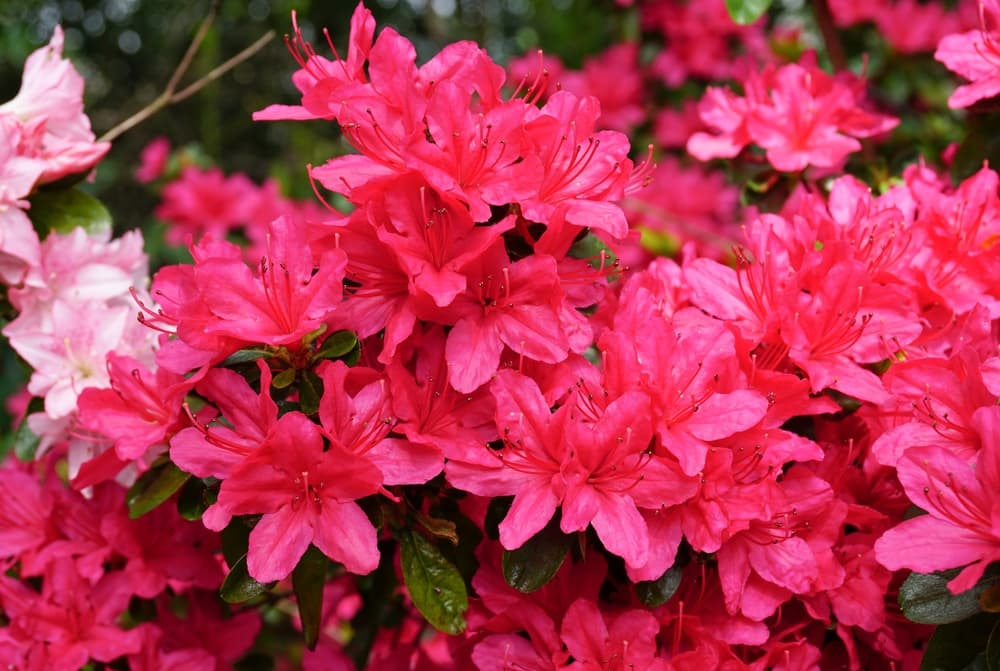
- NATIVE AREA: JAPAN
- TYPE: Kurume; Evergreen
- RHS AWARD OF GARDEN MERIT
A dwarf with a compact, mounding form of about 0.6m high and up to 1m wide.
The leaves take on a bronzed tone in winter.
The medium-sized flowers are about 6cm and are hose-in-hose or double.
They are a solid colour; a brilliant Lipstick Red and bloom in May.
12) R. ‘Fruit Salad’

- COMMON NAME: FRUIT SALAD
- NATIVE AREA: CULTIVATED
- TYPE: Deciduous
The plant reaches 1.2-1.5m – the smallish flowers are about 5cm.
They are funnel-shaped and present a star-like face.
The petals are a vivid pink with streaks of deep pink and red, while the dorsal petal is a rich orange, with adjacent petals displaying light orange flashes.
The scented flowers bloom in late June.
13) R. ‘Elsie Lee’
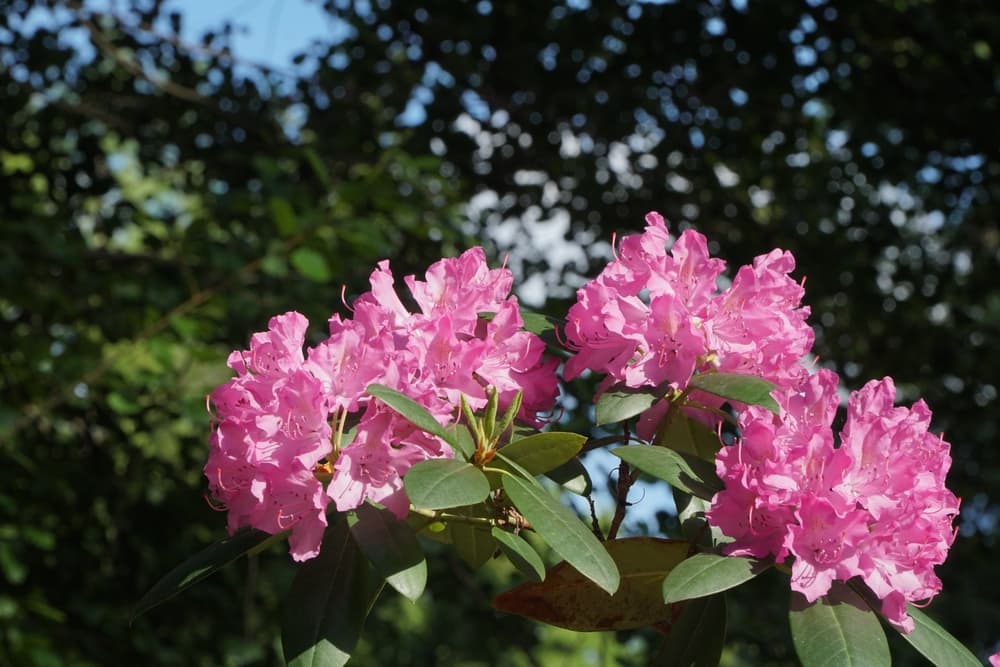
- COMMON NAME: ELSIE LEE
- NATIVE AREA: UNITED STATES
- TYPE: Knap Hill (Exbury)
- RHS AWARD OF GARDEN MERIT
A semi-dwarf variety that attains a height and spread of about 0.8m.
Semi-double flowers with delightful, richly ruffled petals of a pale yet bright lilac-purple hue.
Medium-sized, about 6cm flowers bloom in profusion in late May.
14) R. ‘Schneeperle’

- NATIVE AREA: UNITED STATES
- TYPE: Knap Hill (Exbury)
Dwarf variety of only about 0.35m with a spread of 0.5m having a creeping, clumping form.
The flowers are small at about 4cm and are in double form.
Like a bridal veil they are snowy white but are embellished with a greenish-yellow-tinged throat.
The petals have wavy edges and flowers bloom in May.
15) A. ‘George L. Taber’

- COMMON NAME: George Taber Southern Indica Azalea
- NATIVE AREA: SOUTHERN INDIA
- TYPE: Southern Indica
Grows to just over 2m tall and just under 2m spread.
It is very heat tolerant and the flowers have a classic funnel shape and are large at 7-8cm.
The smooth petals are a pale orchid hue with an intense rose-mauve flare and flecks on the dorsal petal.
Flowers bloom in profusion in mid- and late-spring.
16) R. ‘Addy Wery’
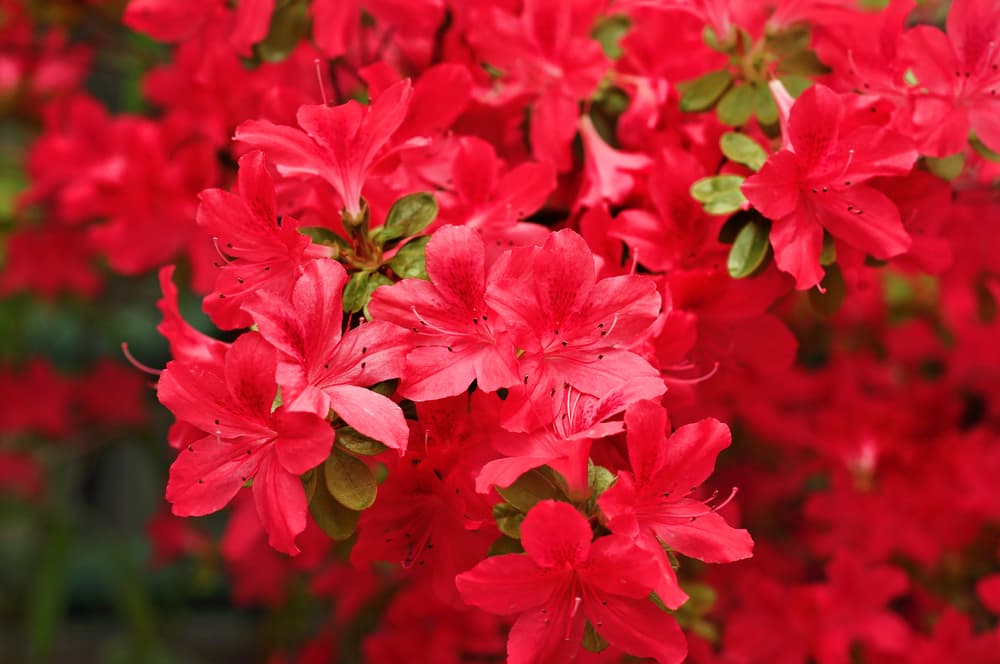
- COMMON NAME: ADDY WERY AZALEA
- NATIVE AREA: JAPAN
- TYPE: Kurume
This compact plant reaches a height of up to 1.2m.
Bears small trumpet-shaped flowers of 4-4.5cm.
They are a deep, rich vermilion to red; almost a solid colour bar slight gradation from the centre.
Blooms profusely in late April through early May.
17) R. ‘Iro Hayama’
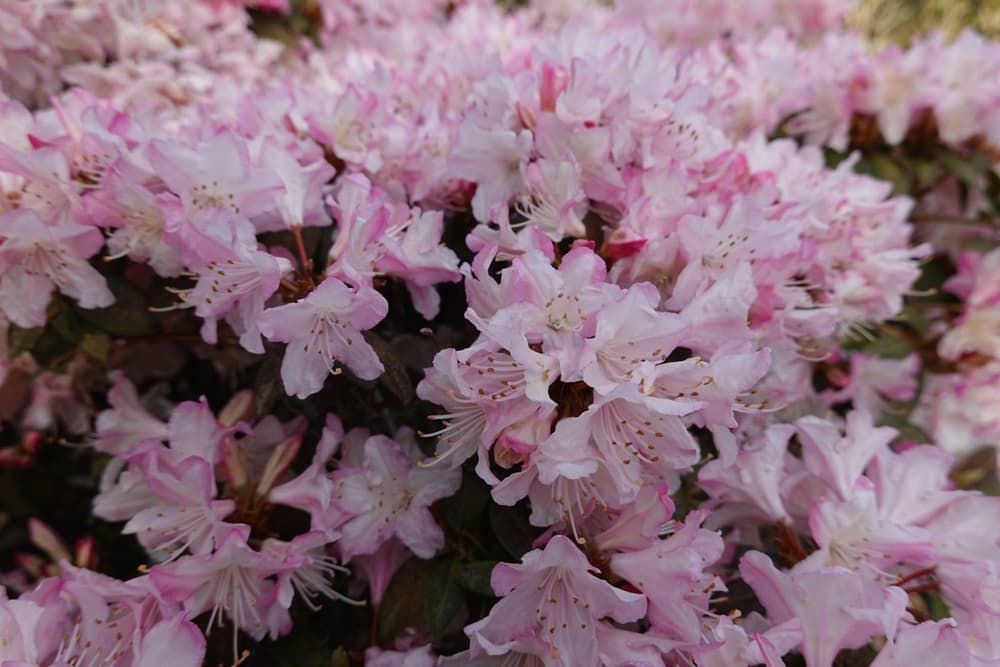
- COMMON NAME: IRO HAYAMA
- NATIVE AREA: JAPAN
- TYPE: Kurume
- RHS AWARD OF GARDEN MERIT
This semi-dwarf variety has a mounding form and reaches a height and spread of about 1m.
It bears small, 4cm trumpet-shaped flowers.
The smooth petals are white gently gradating to a pale lavender or pale mauve.
Flowers present an elegant, delicate appearance. Blooms in May.
18) R. ‘Panda’

- COMMON NAME: PANDA AZALEA
- NATIVE AREA: JAPAN
- TYPE: Evergreen
- RHS AWARD OF GARDEN MERIT
Neither tubby nor black-and-white; rather, it bears the most delicate, indeed fragile-seeming, of Azalea flowers.
This plant is a dwarf with a spreading habit that grows to only 30-40cm.
The small flowers are only about 3cm.
Petals are in an unusual imbricate form and are snow-white, appearing wispy or filmy, with the golden yellow of the anthers providing a strong contrast.
It bears a profusion of flowers in May.
19) The Encore Series
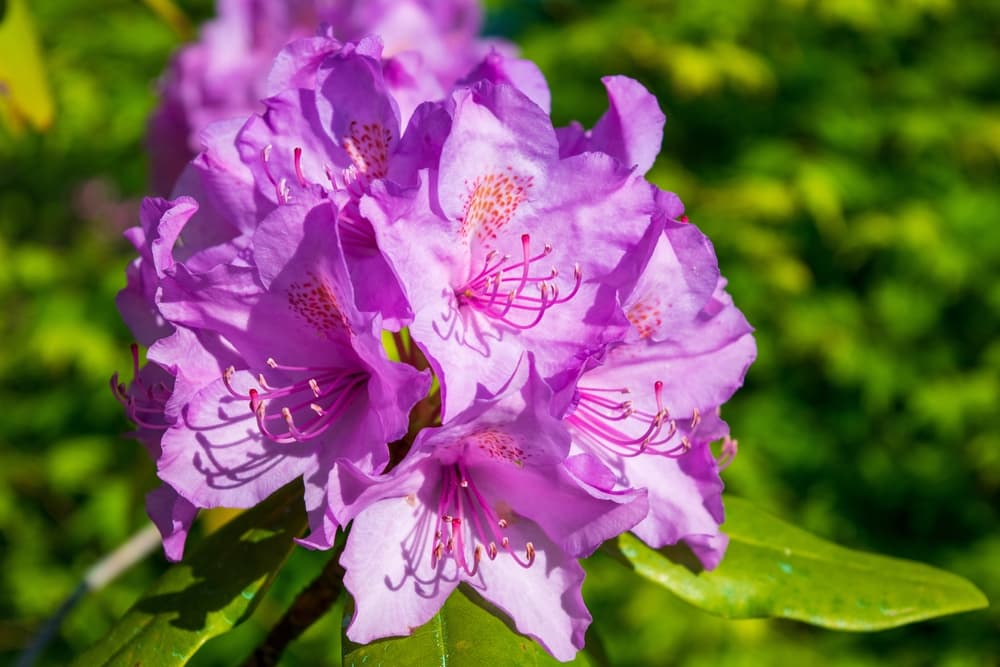
- COMMON NAME: ENCORE AZALEA
- NATIVE AREA: CULTIVATED
- TYPE: Encore
Encore is a patented brand of re-blooming Azaleas that were cultivated in Lousiana as recently as the 1980s.4S. (2022b, September 29). Encore Azaleas lead the way in LA. Encore Azalea. Retrieved March 10, 2023, from https://encoreazalea.com/news/encore-varieties-lead-multi-season-azaleas/
They produce flowers, sometimes abundantly, from spring clear into autumn, or produce blooms once in spring and again, often more profusely, in autumn.
They are relatively heat-tolerant.
Azalea Types Explained
Evergreen Azaleas typically have a mounding form and are compact whereas deciduous ones are usually taller with less branching.
Evergreen
The evergreen forms bloom earlier in spring and do so profusely but the flowers are almost always unscented while the deciduous ones bloom in mid or late spring, with the flowers coming slower and less densely but typically having a sweet fragrance.
Evergreen Azaleas, for the most part descending from sub-genus Tsutsusi, are divided into four groupings.
Kurume Azaleas or Rhododendron obtusum Group
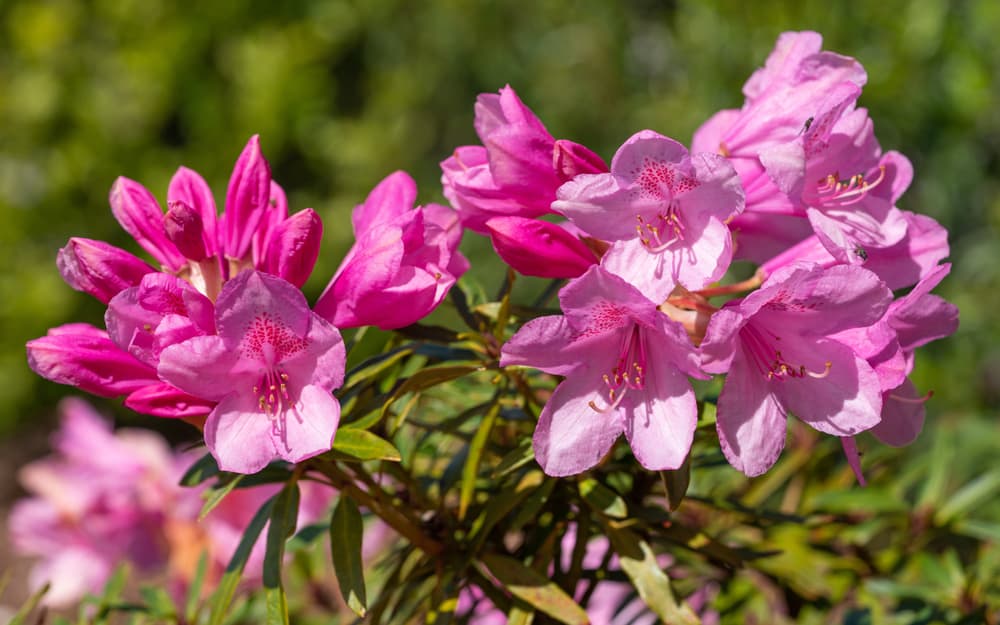
Hybrids from Japanese species like R. kiusianum.
They are dense, small plants, reaching just over a metre, and bloom in early spring, usually profusely.
Many of the most desirable and popular evergreen Azaleas and RHS Award of Garden Merit recipients are Kurumes.
Southern Indian Azaleas or Rhododendron indica

Also hybrids and also descend from Japanese species and have nothing to do with India.
They are less dense and bigger, attaining heights of over 2m.
They bloom in mid-spring. They include exceptions like the ten-stamened ‘George Lindley Taber’.
This group is further sub-divided into cold-hardy Southern Indian Azaleas which can be grown as garden plants, and greenhouse Belgian Indian Azalea, which displaced the former as the Azalea of choice in England.
Kaempferi Azaleas

The third group of ‘evergreen’ hybrids comprises of the Kaempferi Azaleas which are usually semi-evergreen.
Like the Kurume Azaleas, these plants grow to about a metre but like the Southern Indian Azaleas they bloom in mid-to-late spring.
Reblooming Azaleas
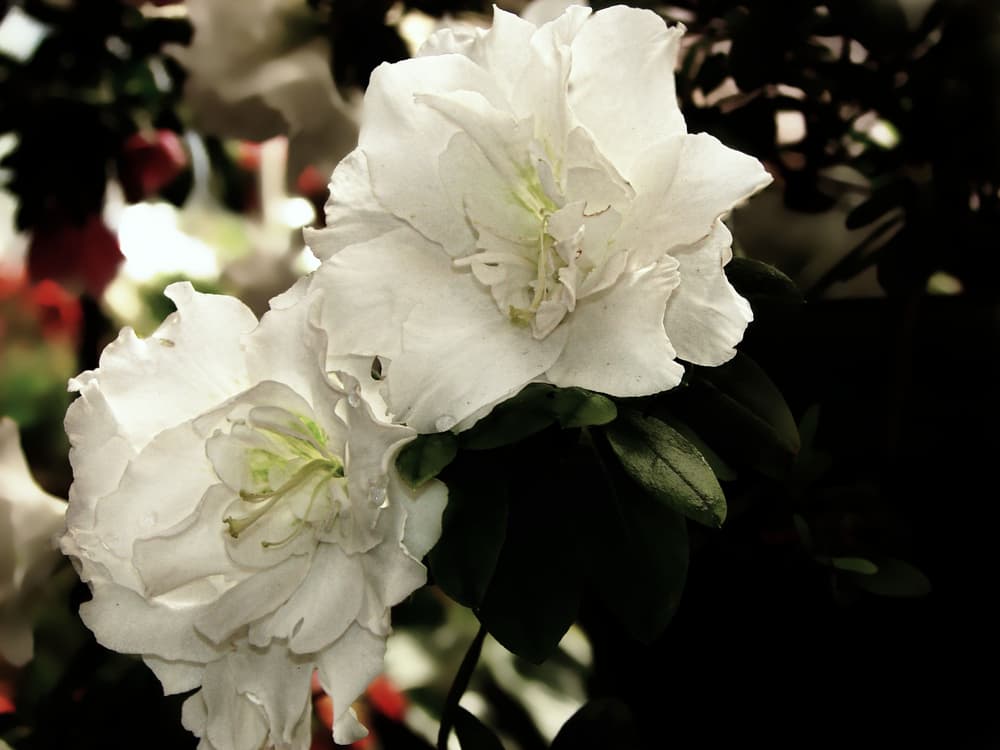
The fourth and final evergreen group of hybrids are Reblooming Azaleas.
They too share attributes with both ‘major’ groups, being similar to the Kurumes in plant size but similar to the Southern Indian Azaleas in flowers and foliage.
This group is very attractive for blooming twice, once in spring and then again, usually more profusely, in autumn.
Encore is probably the most well-known and popular producer of such Azaleas and is on the way to becoming a grouping of its own.
Deciduous
Deciduous Azaleas which mainly descend from sub-genus Pentanthera species are usually divided into four groupings.
The oldest hybridisation of deciduous species are the ‘Ghent Azaleas’, which date from the 1820s.518. Ghent-azaleas. (n.d.). University of Bergen. Retrieved March 10, 2023, from https://www.uib.no/en/universitygardens/137155/18-ghent-azaleas
These descend from crosses of American species with the sole European species.
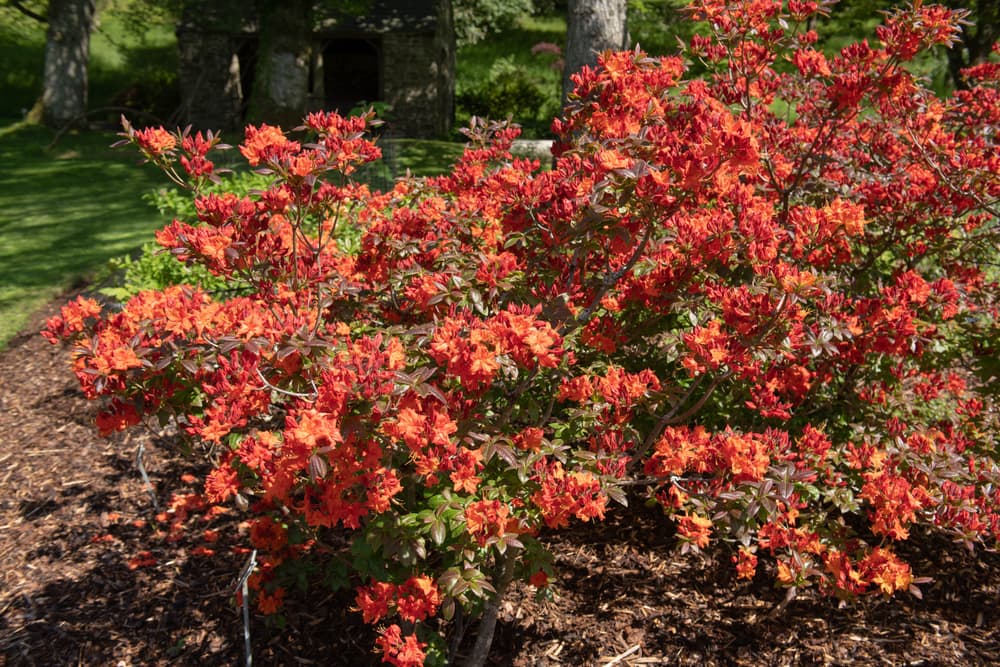
These plants have a somewhat rounded form with a height and spread of about 2.5m.
They are generally disease-resistant, robust plants; flowers are small and fragrant, and their double forms are renowned.
Mollis Azaleas

The Belgian-Dutch ‘Mollis Azaleas’ date from about 1840 and derive mainly from R. japonicum and not from R. molle, notwithstanding the (erroneous) nomenclator.6Rhododendron: The Hybrids / Azalea Hybrids. (n.d.). Trees and Shrubs Online. Retrieved March 10, 2023, from https://treesandshrubsonline.org/articles/rhododendron-the-hybrids-azalea-hybrids-deciduous/
They have a mounded form with a height of about 1.5m but a spread of nearly 2.5m.
They are more cold-hardy, while their flowers are almost always unscented and the colours run through the orange-red spectrum.
Knap Hill Azaleas
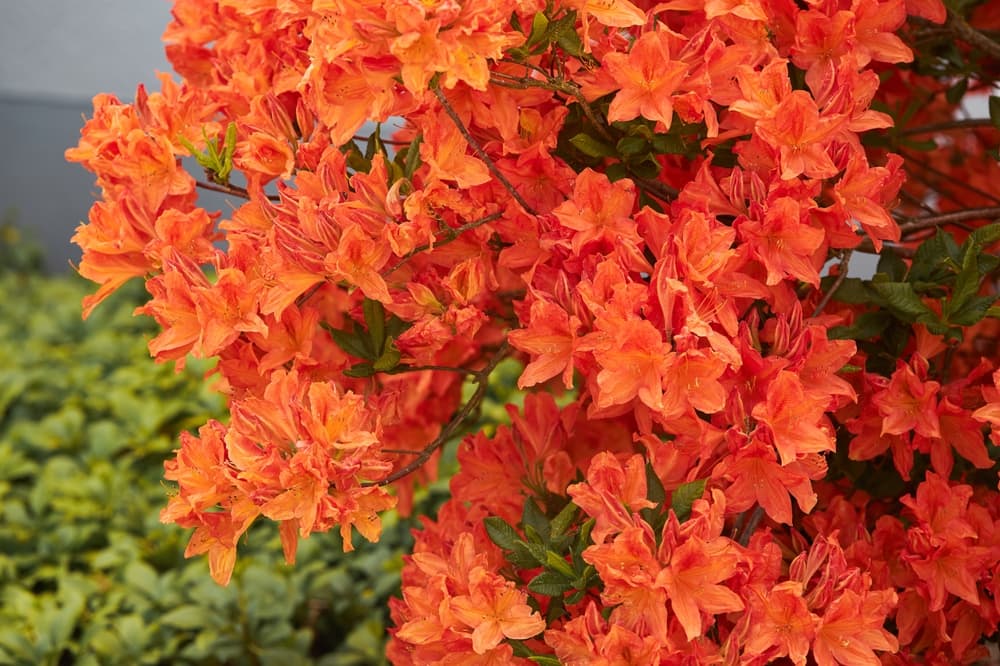
The ‘Knap Hill Azaleas’ are a miscellany of hybrids that descend from both East Asian and American species as well as the sole European one.
This group was bred by Waterer pere et fils from the 1850s onward.
Varieties usually grow to about 1.5m but some attain heights of 2.5m.
Spreads are typically from 2-3m.
Flowers are distinctly larger and often have saturated hues in a wider spectrum from yellow through crimson, and include whites and pinks.
Exbury Strain
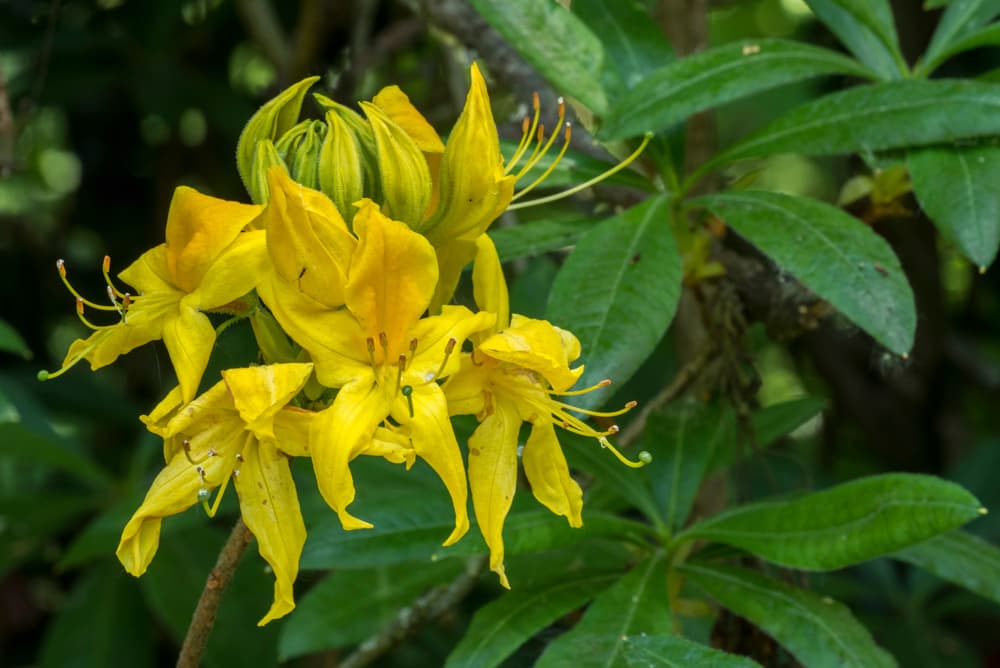
Finally, we have the ‘Exbury Strain’ of the ‘Knap Hills’ or the ‘Exbury Azalea’ Group that was cultivated in the 1920s, mostly deriving from the Knap Hills.7Exbury Azaleas – From History To Your Garden. (n.d.). Virginia Tech. Retrieved March 10, 2023, from https://scholar.lib.vt.edu/ejournals/JARS/v40n1/v40n1-cash1.htm
These reach heights of 1-1.5m and are cold-hardy varieties.
Flowers are large and have particularly deep and rich hues in the yellow to red spectrum.
Seeds and flowers of this strain were exported to the United States, and now the Exburys are considered the most important grouping of deciduous Azaleas in American floriculture.
It is to be noted that the above horticultural classification is an ‘Atlanticist’ one.
Japanese, Chinese, and Korean horticulturalists and their respective floral trades have their own classification and groupings for Azalea cultivars.
References
- 1Azalea Society of America. (2018b, August 14). Learn about azaleas. Retrieved March 10, 2023, from https://www.azaleas.org/about-azaleas/
- 2Rhododendron schlippenbachii Maxim. (n.d.). Kew Royal Botanic Gardens. Retrieved March 10, 2023, from https://powo.science.kew.org/taxon/urn:lsid:ipni.org:names:333307-1
- 3Rhododendron viscosum. (n.d.). Wildflower Center. Retrieved March 10, 2023, from https://www.wildflower.org/plants/result.php?id_plant=rhvi2
- 4S. (2022b, September 29). Encore Azaleas lead the way in LA. Encore Azalea. Retrieved March 10, 2023, from https://encoreazalea.com/news/encore-varieties-lead-multi-season-azaleas/
- 518. Ghent-azaleas. (n.d.). University of Bergen. Retrieved March 10, 2023, from https://www.uib.no/en/universitygardens/137155/18-ghent-azaleas
- 6Rhododendron: The Hybrids / Azalea Hybrids. (n.d.). Trees and Shrubs Online. Retrieved March 10, 2023, from https://treesandshrubsonline.org/articles/rhododendron-the-hybrids-azalea-hybrids-deciduous/
- 7Exbury Azaleas – From History To Your Garden. (n.d.). Virginia Tech. Retrieved March 10, 2023, from https://scholar.lib.vt.edu/ejournals/JARS/v40n1/v40n1-cash1.htm


